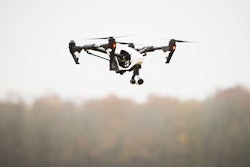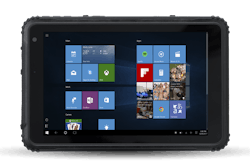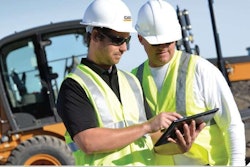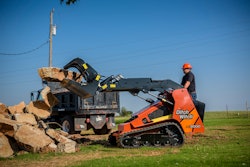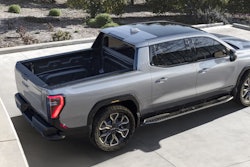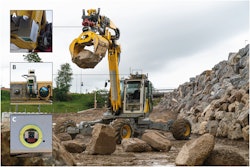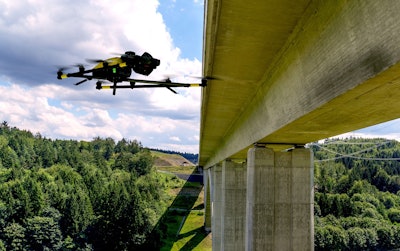 The Intel Falcon 8+ System is outfitted for industrial inspection, surveying and mapping. Photo Credit: Intel
The Intel Falcon 8+ System is outfitted for industrial inspection, surveying and mapping. Photo Credit: Intel“DATA IS THE NEW OIL”
The words flashed upon the large screen in giant letters above Intel CEO Brian Krzanich’s head shortly after he took the stage at the International Drone Conference and Exposition (InterDrone) in Las Vegas earlier this week.
The phrase is integral for understanding not only Intel’s new role as a drone company, but also why construction companies should care.
Though Krzanich’s behemoth company has built its name on microprocessors, the tiny silicon chips that act as the brains of our personal computers, he wasn’t at the conference to talk about processors. Rather, Krzanich’s keynote address focused on the introduction of the Intel Insight Platform for drones.
The new cloud-based platform is designed to harness the flood of data drones are capable of producing and help industrial users, like those in construction, make sense of it all.
“If you go back to the turn of the century, oil was transforming every industry. … The combustion engine turned oil into something even more productive,” Krzanich said. “But when oil was discovered it was actually thought of as a nuisance material. People didn’t know what to do with it.”
Data—though it is capable of providing “insights and opportunities to everyone who wants to understand what’s going on around them,” as Krzanich put it—went through a similar nuisance stage as early memory systems struggled to provide enough space for storing all the data being created.
But now, Krzanich says data has found its combustion engine.
“Artificial intelligence (AI) is extracting insights and understanding and value out of data and it’s become one of the most valuable commodities,” he said.
Krzanich added that when you bring drones together with data and AI, “the whole world will begin to change.”
“The future of drones is more about what you can do with that data and what that data means and the insights it provides than the actual flight itself. And that’s an important shift that we all need to start thinking about,” Krzanich said.
Like spell check for inspections
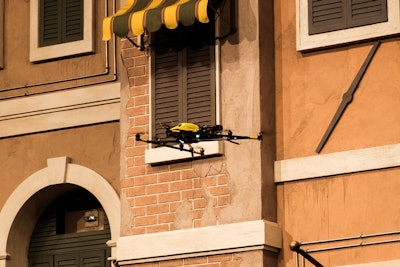 Intel’s Falcon 8+ eight-rotor industrial drone flies a demonstration inspection of a facade during an InterDrone 2017 keynote.
Intel’s Falcon 8+ eight-rotor industrial drone flies a demonstration inspection of a facade during an InterDrone 2017 keynote.Krzanich then demonstrated the capabilities of the Insight Platform by doing a structural inspection in the conference hall. A curtain on the left side of the stage was pulled and out of the black appeared the two-story facade of a building with windows, doorways, awnings, wall-mounted flagpoles and more.
He talked a bit about how Intel’s latest commercial eight-rotor drone, the Falcon 8+ features Real Sense technology, which utilizes cameras and depth of field sensing in order to avoid obstacles and keep a safe distance from the surface being inspected. The drone also has an impressive indoor location technology on-board which provides location data when GPS cannot be used.
Krzanich oversaw a piloted inspection of the facade and a second inspection flown autonomously that was launched by Intel Mission Control, a flight planning software.
Upon return of the second inspection flight, the Insight Platform got to work.
Krzanich showed the process of uploading images to Insight which, even before processing takes place, gives the user a pre-visualization of the operation you’ve just flown. This pre-visualization is like a rough sketch of the inspection surface with the photos organized and placed with respect to their proximity and orientation to one another based on location data. It allows operators to ensure that the operation went as planned before uploading the photos to Insight for processing—which can take a few hours.

After the photos are processed in the cloud they are delivered as a 2D or 3D model. For this demo, Krzanich used a 2D model generated beforehand. He then demonstrated a feature called change detection which Intel says works “like a spell check function,” cycling through each of the detected changes in the facade between the latest inspection and a previous inspection. During the demo, the software was able to detect large differences, such as sections of stucco having chipped away or a missing balcony column, and very small changes like a badly installed drain bracket and a missing flag mount.
Though Insight is capable of producing 2D and 3D models, Krzanich says that it is currently only able to provide analysis on 2D models. “We are looking at being able to do analysis on 3D models,” in the future, he said.
The company says the platform “will address a range of commercial applications and verticals—from inspections and surveying in construction, mining, precision agriculture, oil and gas, and more.”
Intel is initially offering Insight to select enterprise accounts only.
Automation is the aim
During his keynote address, Krzanich said that Intel’s work in applying machine learning to drone hardware like the Falcon and analytical software like Insight is all in the service of increasing automation.
“These systems, these drones have to become more and more automated,” he said. “Especially when we think of visual line of sight or flights over groups of people or at night. The system has to become more automated more intelligent.”




